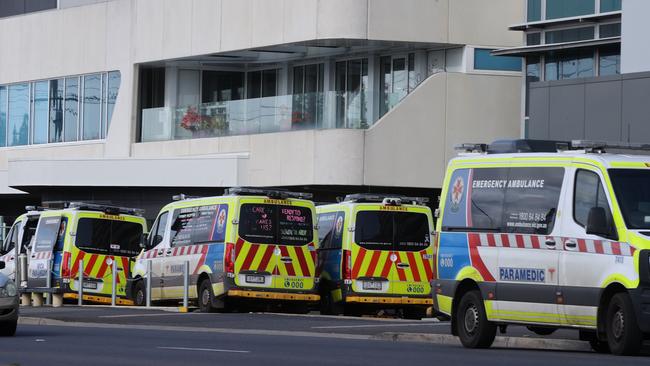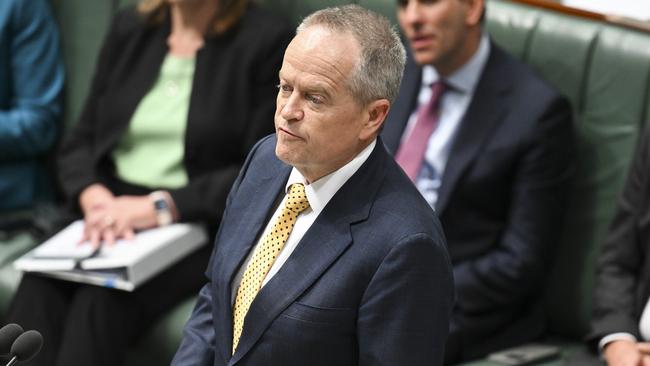‘Curse of federated system’ leaves beds blocked, ambulances ramped: AMA
Doctors warn state and federal health ministers must share responsibility for aged care and NDIS to keep the nation from getting sicker.

State and federal health ministers must share responsibility for aged care and NDIS to keep the nation from getting sicker and prevent “jurisdictional infighting” over public hospitals, Australia’s leading medical advisory body says.
The Australian Medical Association has raised concerns that siloing the National Disability Insurance Scheme and aged care from health policy left public hospitals prone to bed blocks, when a patient with a disability or health complication struggles to find a place to go after their hospital treatment concludes.
AMA vice-president Julian Rait said public healthcare in Australia was falling victim to the “curse of the federated system”, meaning federal health authorities had little incentive to intervene in the responsibilities of state governments.
“This is a classic example about where jurisdictional infighting and cost-shifting causes troubles, because there’s really no incentive for those federal agencies necessarily to help the state hospitals out of their issues, and yet that’s obviously a problem for everyone,” Associate Professor Rait said.
“It’s very hard to co-ordinate aged care, or get it working in a timely way … Similarly, trying to get NDIS support and all the documentation and approvals in place to have the home environment modified appropriately can be a bit of a nightmare for someone who is discharged safely to home.
“Those systems don’t interact very well. They’re separate silos, and therefore problematic.”

He said a tidy solution across aged care, disability services, the Health Department and state services might be as simple as aligning the software each group used in triage.
“We’ve seen a log jam in public hospitals,” Professor Rait said. “Greater co-operation between the federal Department of Health and various state bodies would be helpful but I’m not holding my breath. In the 30-plus years I’ve been practising, I haven’t seen it improve very much.
“From a funding perspective, people think it’s great, because in their own little silo it saves money while they procrastinate, but the health system suffers as a consequence of the failings of both the aged-care system and the NDIS.
“Unless there’s some sort of change of culture somewhere, we’re not going to see this improve very quickly.”
On December 27, NDIS Minister Bill Shorten announced hospital discharge times for NDIS participants had reached their lowest average, at 20 days.
“In 2022, it was estimated that in some hospitals across Victoria that an unacceptable number of people with disability – who were medically ready to be moved from hospital – were having to wait an average of 160 extra days to be discharged,” he said. “Having people spend unnecessary amounts of time in hospital prevents them from living the lives they want but also comes at the expense of the public health system.”
Reform since June 2022 has focused on appointing health liaison officers and specialist planners to cut the divide between hospitals and disability service providers.

“This reduction to discharge times is the result of the agency working with state health systems to ensure everyone is notified when a participant enters hospital, so the National Disability Insurance Agency can then get to work in establishing a discharge plan,” Mr Shorten said.
“In the past, there have been barriers to reducing hospital discharge times. We’re now seeing better communication between state and federal systems, who are working more closely together.
“The system isn’t perfect – we know we can still do better – but I’m pleased these times have reduced so significantly. It’s freeing up hospital beds for other Australians; more importantly, it’s helping participants get back to their lives so they can get on with living and achieve the positive outcomes the scheme supports.”
Consumer Health Forum chief executive Elizabeth Deveny said streamlining issues such as bed blocks were endemic to the national framework with which health services were viewed in Australia.
“We also need to make sure they don’t fragment care by having one person looking after one part of your healthcare and another person doing other things and those two parts not communicating well,” she said.
“We talk about the ambulance at the bottom of the cliff and the ambulance at the top of the cliff as if there’s only one ambulance, but of course the ambulances are everywhere and we need the policy settings to reflect that.”
The AMA estimates aged-care investment towards hospital in the home policies would prevent $4.4bn in preventable hospitalisation.
NSW experiences the highest rates of bed block nationally. In December 2023, state Health Minister Ryan Park announced an Emergency Department taskforce to address it and other efficiency issues.
The Health Minister’s office pointed to national cabinet medical funding as a co-operative step to curb bed blocks. The $1.2bn package went towards Medicare reforms that reduced hospital pressures.
“The Albanese government doesn’t want older Australians to spend longer in hospital when they can be receiving care back in their home or aged-care home,” a spokesperson for Health Minister Mark Mr Butler said.
“The Albanese government is working closely with the states and territories to implement this funding to prevent older Australians from having to go to hospital in the first place if they don’t really need to.”





To join the conversation, please log in. Don't have an account? Register
Join the conversation, you are commenting as Logout